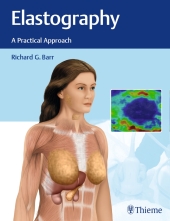 Neuerscheinungen 2016Stand: 2020-02-01 |
Schnellsuche
ISBN/Stichwort/Autor
|
Herderstraße 10
10625 Berlin
Tel.: 030 315 714 16
Fax 030 315 714 14
info@buchspektrum.de |

Richard G. Barr
Elastography
A Practical Approach
2016. 200 S. 400 Abb. 280 mm
Verlag/Jahr: THIEME, STUTTGART 2016
ISBN: 1-62623-271-7 (1626232717)
Neue ISBN: 978-1-62623-271-6 (9781626232716)
Preis und Lieferzeit: Bitte klicken
This practical guide is a compilation of firsthand expertise from leading authorities around the world on the use of ultrasound elastography. The stiffness or softness of the imaged tissue derived from elastography provides accurate radiologic diagnosis for disease processes including cancer, inflammation, and fibrosis. It is an efficacious and accurate diagnostic imaging modality that helps avoid invasive biopsies.
The first two chapters cover basic fundamental principles of elastography, with subsequent chapters exploring pathology-specific utilization. The authors cover the extensively validated and implemented use of elastography for diffuse liver disease, and diseases of the breast andthyroid gland. They also discuss the potential benefits and limitations for the prostate, spleen, pancreas, kidneys, musculoskeletal system, salivary glands, lymph nodes, and testes. The book concludes with a chapter on potential future applications of this ever-evolving technology.
Key Highlights
Discussion of key differences between strain elastography and shear wave elastography by individual organ systems
Clinical pearls on how to accurately perform elastography and tips for avoiding false-positive or false-negative results
Case studies elucidate the targeted use of elastographic findings by specific pathology
Illustrations in the breast and liver chapters demonstrate precise transducer techniques
MRI elastography as an emerging and safe assessment tool, primarily for the diagnosis of liver disease, with emergent potential for additional organs
This book provides key knowledge on visualizing quantifiable differences in tissue elasticity and applying this data to improved treatment strategies for diverse pathologies. It is essential reading for radiologists, sonographers, and imaging technicians.


